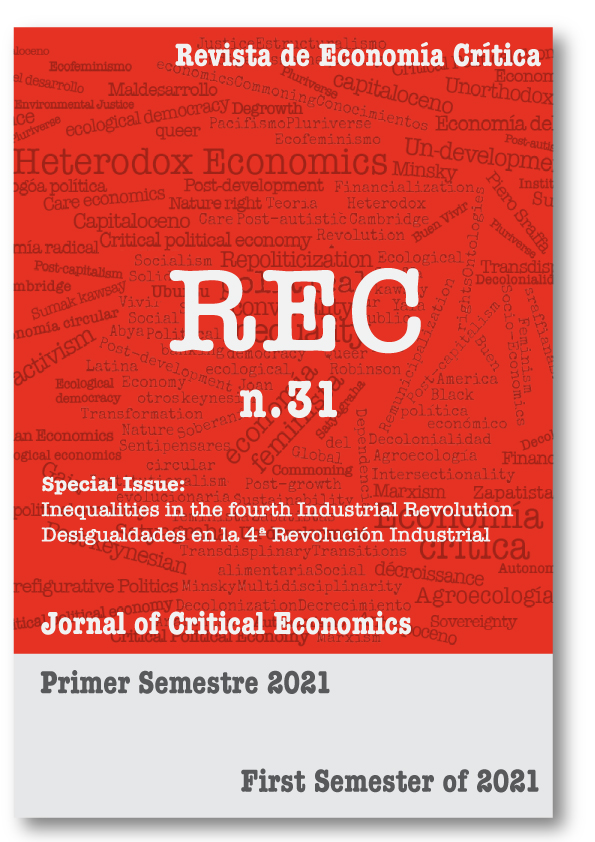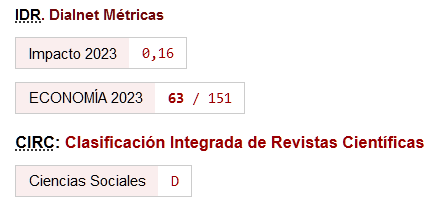Factores de desigualdad entre teletrabajadores en Europa.
DOI:
https://doi.org/10.46661/rec.10536Palabras clave:
Teletrabajo, trabajo móvil, desigualdades, condiciones laboralesResumen
Los cambios tecnológicos provocados por la digitalización, la automatización y la globalización están permitiendo que más trabajadores/as puedan desempeñar sus tareas desde múltiples ubicaciones. Esta expansión del teletrabajo, estimulada aún más por la pandemia del COVID-19, transforma no solo los espacios y tiempos de trabajo, sino también las relaciones laborales y condiciones de empleo. Nuestro objetivo es explorar las nuevas desigualdades entre distintos tipos de trabajadores atendiendo a la intensidad y lugar de uso de las tecnologías. El estudio empírico utiliza datos de más de veinte mil trabajadores de la UE-15 de la 6ª Encuesta Europea de Condiciones de Trabajo para analizar, mediante modelos de regresión logística multinomial, los diferentes perfiles de teletrabajadores. El análisis muestra la tendencia al aumento en la heterogeneidad de los perfiles de teletrabajadores/as y a desigualdades crecientes entre ellos. Hay grandes diferencias entre los distintos tipos de teletrabajadores atendiendo a la ocupación, el sector de actividad y el país. Las mujeres se encuentran mayoritariamente en el grupo de teletrabajadores más precarios y con peores condiciones laborales.
Descargas
Citas
Aguilera, Anne; Lethiais, Virginie; Rallet, Alain y Laurent Proulhac (2016). "Home-Based Telework in France: Characteristics, Barriers and Perspectives." Transportation Research Part A: Policy and Practice, 92(October): 1–11. https://doi.org/10.1016/j.tra.2016.06.021
Allen, Tammy D.; Johnson, Ryan C.; Kiburz, Kaitlin M. y Shockley Kristen M. (2013). "Work-Family Conflict and Flexible Work Arrangements: Deconstructing Flexibility." Personnel Psychology, 66(2), 345–76. https://doi.org/10.1111/peps.12012
Bailey, Diane E. y Kurland, Nancy B. (2002). "A Review of Telework Research: Findings, New Directions, and Lessons for the Study of Modern Work." Journal of Organizational Behavior, 23 (SPEC. ISS.), 383–400. https://doi.org/10.1002/job.144
Bettio, Francesca y Plantenga, Janneke (2004). "Comparing Care Regimes in Europe". Feminist Economics, 10:1, 85-113. doi:10.1080/1354570042000198245
Biron, Michal y Van Veldhoven, Marc (2016). "When Control Becomes a Liability Rather than an Asset: Comparing Home and Office Days among Part‐time Teleworkers." Journal of Organizational Behavior, 37(8), 1317–37. https://doi.org/10.1002/job.2106
Boell, Sebastian K; Cecez-Kecmanovic, Dubravka y Campbell, John (2016). "Telework Paradoxes and Practices: The Importance of the Nature of Work." New Technology, Work, and Employment ,31(2), 114–31. https://doi.org/10.1111/ntwe.12063
Boogaard, JanJaap y Moller, Sven (2020). "Exploring the Post-COVID-19 Workplace." Colliers International, 16.
Brodt, Torsten L. y Verburg, Robert M. (2007). "Managing Mobile Work - Insights from European Practice." New Technology, Work and Employment, 22(1), 52–65. https://doi.org/10.1111/j.1468-005X.2007.00183.x
Chung, Heejung y Van der Horst, Mariska (2018). "Women's Employment Patterns after Childbirth and the Perceived Access to and Use of Flexitime and Teleworking." Human Relations, 71(1), 47–72. https://doi.org/10.1177/0018726717713828
Chung, Heejung y Van der Lippe, Tanja (2018). "Flexible Working, Work–Life Balance, and Gender Equality: Introduction." Social Indicators Research. https://doi.org/10.1007/s11205-018-2025-x
Daly, Mary y Lewis, Jane (2000). "The concept of social care and the analysis of contemporary welfare states". The British Journal of Sociology, vol. 51 (2), 281-298. https://doi.org/10.1111/j.1468-4446.2000.00281.x
Elldér, Erik (2019). "Who Is Eligible for Telework? Exploring the Fast-Growing Acceptance of and Ability to Telework in Sweden, 2005-2006 to 2011-2014." Social Sciences, 8(7), 16. https://doi.org/10.3390/SOCSCI8070200
Eurofound. (2020a). Telework and ICT-based mobile work: Flexible working in the digital age. Luxembourg: Publications Office of the European Union. https://doi.org/10.2806/70118
Eurofound. (2020b). Living, working and COVID-19 First findings – April 2020, (April), 11. Disponible en: https://www.eurofound.europa.eu/sites/default/files/ef_publication/field_ef_document/ef20058en.pdf
Eurofound y the International Labour Office (2017). Working anytime, anywhere: the effects on the world of work. Publications Office of the European Union, Luxembourg, and the International Labour Office, Geneva.
Eurostat (2020). High-tech industry and knowledge-intensive services (htec). Reference Metadata in Euro SDMX Metadata Structure (ESMS). Disponible en: https://ec.europa.eu/eurostat/cache/metadata/en/htec_esms.htm]. Consultado el 6 de agosto de 2020.
Frey, Carl Benedikt y Osborne, Michael A. (2017). "The Future of Employment: How Susceptible Are Jobs to Computerisation?" Technological Forecasting and Social Change, 114, 254–80. http://dx.doi.org/10.1016/j.techfore.2016.08.019
Fuller, Sylvia y Hirsh, C. Elizabeth (2019). "'Family-Friendly' Jobs and Motherhood Pay Penalties: The Impact of Flexible Work Arrangements Across the Educational Spectrum." Work and Occupations, 46(1), 3–44. https://doi.org/10.1177/0730888418771116
Gallouj, Faïz; Weber, K. Matthias; Stare, Metka y Rubalcaba, Luis (2015). "The Futures of the Service Economy in Europe: A Foresight Analysis." Technological Forecasting and Social Change, 94, 80–96. https://doi.org/10.1016/j.techfore.2014.06.009
Giovanis, Eleftherios (2018). "Are Women Happier When Their Spouse Is Teleworker?" Journal of Happiness Studies, 19(3), 719–54. https://doi.org/10.1007/s10902-017-9847-0
Golden, Timothy D.; Veiga, John F. y Simsek, Zeki (2006). "Telecommuting's Differential Impact on Work-Family Conflict: Is There No Place like Home?" Journal of Applied Psychology, 91(6), 1340–50. https://doi.org/10.1037/0021-9010.91.6.1340
Gschwind, Lutz y Vargas, Oscar (2019). "Telework and Its Effects in Europe." In J. C. Messenger (Ed.), Telework in the 21st Century (pp. 36–75). Edward Elgar Publishing. https://doi.org/10.4337/9781789903751.00007
Haddon, Leslie y Brynin, Malcolm (2005). "The Character of Telework and the Characteristics of Teleworkers." New Technology, Work and Employment, 20(1), 34–46. https://doi.org/10.1111/j.1468-005X.2005.00142.x
Hartig, Terry; Kylin, Camilla y Johansson, Gunn (2007). "The Telework Tradeoff: Stress Mitigation vs. Constrained Restoration." Applied Psychology, 56(2), 231–53. https://doi.org/10.1111/j.1464-0597.2006.00252.x
Hjorthol, Randi J. (2006). "Teleworking in Some Norwegian Urban Areas—Motives and Transport Effects." Urban Geography, 27(7), 610–27. https://doi.org/10.2747/0272-3638.27.7.610
Holtgrewe, Ursula (2014). "New New Technologies: The Future and the Present of Work in Information and Communication Technology." New Technology, Work and Employment, 29(1), 9–24. https://doi.org/10.1111/ntwe.12025
Huws, Ursula (2016). A Review on the Future of Work: Online Labour Exchanges or Crowdsourcing: Implications for Occupational Health and Safety. Disponible en: https://oshwiki.eu/wiki/A_review_on_the_future_of_work:_online_labour_exchanges_or_crowdsourcing
Hynes, Michael (2014). "Telework isn' t Working: A Policy Review." The Economic and Social Review, Vol. 45(4): 579–602. Disponible en: https://www.esr.ie/article/view/231/100
Illegems, Viviane; Verbeke, Alain y S'Jegers, Rosette (2001). "The Organizational Context of Teleworking Implementation." Technological Forecasting and Social Change, 68(3), 275–91.https://doi.org/10.1016/S0040-1625(00)00105-0
Lim, Vivien y Teo, Thompson (2000). "To Work or Not to Work at Home: An Empirical Investigation of Factors Affecting Attitudes towards Teleworking." Journal of Managerial Psychology, 15, 560–86. https://doi.org/10.1108/02683940010373392
López-Igual, Purificación y Rodríguez-Modroño, Paula (2020). "Who is teleworking and where from? Exploring the main determinants of telework in Europe". Sustainability, 12(21), 1-15.
https://doi.org/10.3390/su12218797
Lott, Yvonne y Chung, Heejung (2016). "Gender Discrepancies in the Outcomes of Schedule Control on Overtime Hours and Income in Germany." European Sociological Review, 32(6), 752-65.
https://doi.org/10.1093/esr/jcw032
Luukinen, Ari (1996). "A Profile of Finnish Telework: Survey Results Concerning the Nature, Extent, and Potential of Telework in Finland." Directions of Telework in Finland: Report by the Finnish Experience with Telework Project: 1-49.
Messenger, Jon y Gschwind, Lutz (2016). "Three Generations of Telework: New ICTs and the (R)Evolution from Home Office to Virtual Office." New Technology Work and Employment, 31(3), 195-208.
https://doi.org/10.1111/ntwe.12073
Mokhtarian, Patricia L.; Bagley, Michael N. y Salomon, Ilan (1998). "The Impact of Gender, Occupation, and Presence of Children on Telecommuting Motivations and Constraints" Journal of the American Society for Information Science, 49(383), 1115-34.
https://doi.org/10.1002/(SICI)1097-4571(1998)49:12<1115::AID-ASI7>3.0.CO;2-Y
Nätti, Joujo; Tammelin, Mia; Antilla, Timo y Ojala, Satu (2011). "Work at Home and Time Use in Finland." New Technology, Work and Employment, 26(1), 68-77.
https://doi.org/10.1111/j.1468-005X.2010.00258.x
Popma, Jan (2013). The Janus face of the 'New Ways of Work.' In European Trade Union Institute (Issue 07). ETUI aisbl, Brussels.
Pyöriä, Pasi (2011). "Managing Telework: Risks, Fears and Rules." Management Research Review, 34(4), 386-99.
https://doi.org/10.1108/01409171111117843
Rodríguez Modroño, Paula (2021). "Non-standard work in unconventional workspaces. Selfemployed women in home-based businesses and co-working spaces." Urban Studies,
https://doi.org/10.1177/00420980211007406
Rodríguez Modroño, Paula y López-Igual (2021). "Job quality and work-life balance of teleworkers." International Journal of Environmental Research and Public Health 18(6), 3239.
https://doi.org/10.3390/ijerph18063239
Rodríguez Modroño, Paula y Matus López, Mauricio (2016). "Políticas de Cuidados a la Infancia y Mayores Dependientes. Evolución y Condicionamiento pro-Mercado." Reforma y Democracia, 66, 99-130. Disponible en: http://www.redalyc.org/articulo.oa?id=357550050004
Scott, Darren M.; Dam, Ivy; Páez, Antonio y Wilton, Robert D. (2012). "Investigating the Effects of Social Influence on the Choice to Telework." Environment and Planning A, 44(5), 1016-31.
https://doi.org/10.1068/a43223
Sewell, Graham y Taskin, Laurent (2015). "Out of Sight, Out of Mind in a New World of Work? Autonomy, Control, and Spatiotemporal Scaling in Telework." Organization Studies, 36(11), 1507-29.
https://doi.org/10.1177/0170840615593587
Standing, Guy (2011). The Precariat: The New Dangerous Class (Vol. 42, Issue 1). Bloomsbury Publishing.
https://doi.org/10.5040/9781849664554
Sullivan, Cath y Lewis, Suzan (2001). "Home‐based Telework, Gender, and the Synchronization of Work and Family: Perspectives of Teleworkers and their Co‐residents". Gender, Work & Organization, 8(2), 123- 145.
https://doi.org/10.1111/1468-0432.00125
Taskin, Laurent y Edwards, Paul (2007). "The Possibilities and Limits of Telework in a Bureaucratic Environment: Lessons from the Public Sector." New Technology, Work and Employment, 22(3), 195–207. https://doi.org/10.1111/j.1468-005X.2007.00194.x.
Ter Hoeven, Claartje L. y Van Zoonen, Ward (2015). "Flexible Work Designs and Employee Well-Being: Examining the Effects of Resources and Demands." New Technology, Work and Employment, 30(3), 237–55. https://doi.org/10.1111/ntwe.12052.
Thulin, Eva; Vilhelmson, Bertil y Johansson, Martina (2019). "New Telework, Time Pressure, and Time Use Control in Everyday Life." Sustainability (Switzerland), 11(11), 17. https://doi.org/10.3390/su11113067.
Vilhelmson, Bertil y Thulin, Eva (2001). "Is Regular Work at Fixed Places Fading Away? The Development of ICT-Based and Travel-Based Modes of Work in Sweden." Environment and Planning A, 33(6), 1015–29. https://doi.org/10.1068/a33207.
Vilhelmson, Bertil y Thulin, Eva (2016). "Who and Where Are the Flexible Workers? Exploring the Current Diffusion of Telework in Sweden." New Technology, Work and Employment, 77–96. https://doi.org/10.1111/ ntwe.12060.
Walrave, Michel y De Bie, Marijke (2005). Teleworking @ Home or Close to Home – Attitudes towards and Experiences with Homeworking, Mobile Working, Working in Satellite Offices and Telecentres. In ESF (Ed.), University of Antwerp. University of Antwerp.
Welz, Christian y Wolf, Felix (2010). Telework in the European Union. European Foundation for the Improvement of Living and Working Conditions (Eurofound): Dublin, Ireland. Disponible en: http://www.eurofound.europa.eu/eiro/studies/tn0910050s/tn0910050s.htm.
Descargas
Publicado
Cómo citar
Número
Sección
Licencia
Derechos de autor 2021 Purificación López-Igual, Paula Rodríguez-Modroño

Esta obra está bajo una licencia internacional Creative Commons Atribución 4.0.
Esta licencia permite a terceros compartir (copiar y redistribuir el material en cualquier medio o formato) y adaptar (remezclar, transformar y crear a partir del material para cualquier finalidad, incluso comercial), siempre que se reconozca la autoría y la primera publicación en esta revista (La Revista, DOI de la obra), se proporcione un enlace a la licencia y se indique si se han realizado cambios en la obra.







